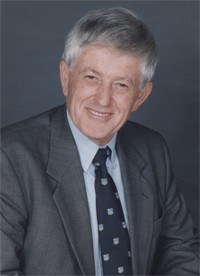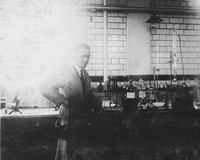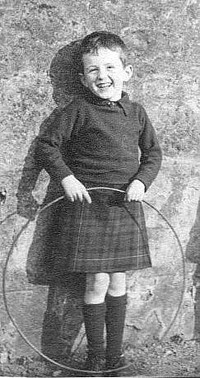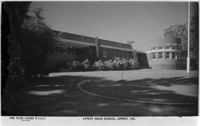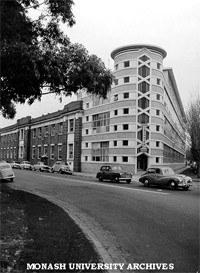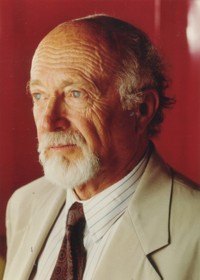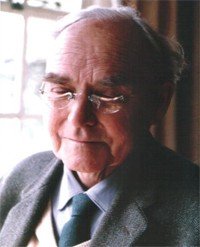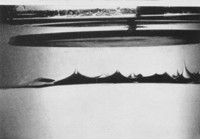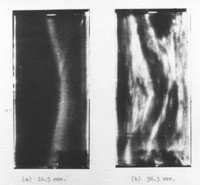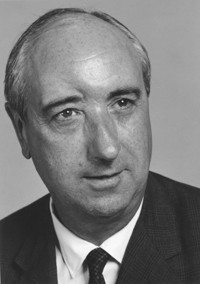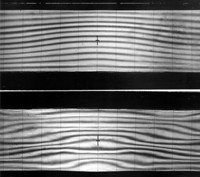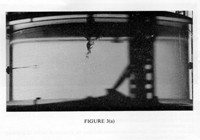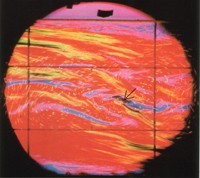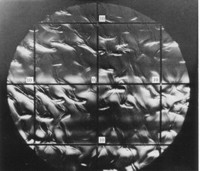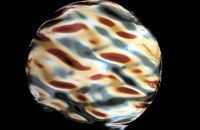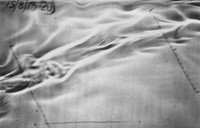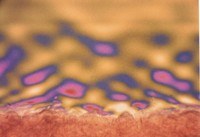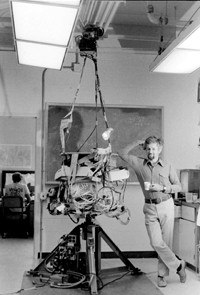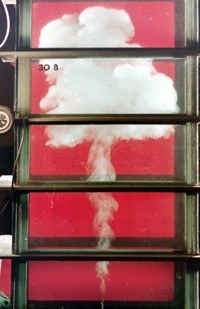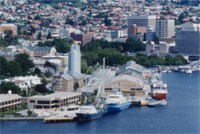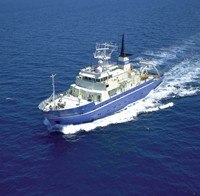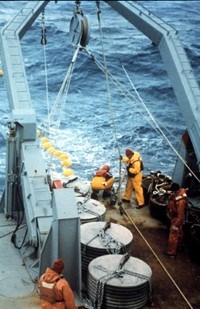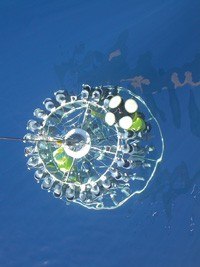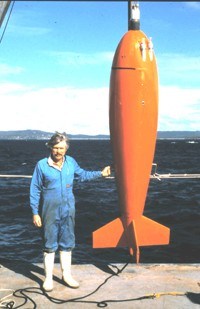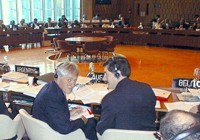Dr Angus McEwan, oceanographer
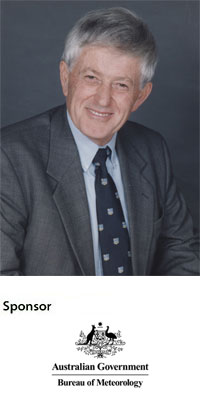
Angus McEwan was born in Alloa, Scotland in 1937. In 1947, after the early death of his father, Angus McEwan immigrated with his mother and three brothers to Melbourne, Australia. McEwan attended Upwey High School and then Melbourne High School finishing with a leaving certificate. Too young for university, McEwan completed a diploma in engineering at Caulfield Technical School. After his National Service, McEwan got a job at the Aeronautical Research Laboratories in Melbourne. A cadetship enabled him to extend his studies at the University of Melbourne where he graduated with a BEMech (Hons) (1960). McEwan was then awarded a Vacuum Oil Scholarship to complete his masters, MEngSc (1962). McEwan again went to work for the Aeronautical Research Laboratories on heat transfer problems.
A desire to change direction in his research found McEwan on his way to Cambridge with a CSIRO Fellowship and, later, a Public Service Board Scholarship. He graduated with a PhD in 1966 for his work on the distortion changes in turbulence as flow goes over a step. He also worked with the legendary Sir Geoffery ('GI') Taylor on liquid surfaces in electric fields. McEwan then returned to Australia and the Aeronautical Research Laboratories to work on hypersonic re-entry problems (1966-69). He then joined the CSIRO Division of Meteorological Physics (later Atmospheric Research) supported by a Queen Elizabeth II Fellowship (1969-71). In 1971 McEwan was appointed as a senior research scientist with the task of creating a geophysical fluid dynamics laboratory within this Division (1971-81). During this period, in 1975, McEwan was invited as a Rossby Fellow to the Woods Hole Oceanographic Institution, USA where he worked on internal waves. In 1981 McEwan was appointed to chief of the new CSIRO Division of Oceanography (1981-95) to be established in Hobart. Following his term as chief, McEwan served as senior science advisor to the Commonwealth Bureau of Meteorology (1995-2005).
In addition to his research, and several roles in the advancement of Australian marine science, McEwan was active in the UNESCO Intergovernmental Oceanographic Commission (IOC). He served in a number of capacities including; Australian delegate to the (IOC) (1982-2004), member (1982-90) and then chairman (1987-90) of the IOC Committee on Climatic Changes and the Ocean, representative of the Global Ocean Observing System (GOOS) steering committee (1995-2003), chairman of the Intergovernmental GOOS committee (1998-2001) and chair of the Oceanographic Data Exchange Policy group (2001-02).
Interviewed by Dr Trevor McDougall in 2011.
Contents
Introduction
Welcome. We are here today to interview Angus McEwan for the Australian Academy of Science video histories program. My name is Trevor McDougall and I will be conducting the interview. Angus has now retired, but his working life in science was in geophysical fluid dynamics. This is the study of fluid motion in geophysical fluids, such as the atmosphere and the oceans of earth. Also, he was Chief of the Division of Oceanography in CSIRO for 14 years and has played a major role in several international programs, coordinating marine science.
McEwan clan
Angus, let's start the interview with a discussion of your family background: your parents and where you were born.
I was born in Alloa, Scotland. It is a little town on the River Forth, about 25 miles North-West of Edinburgh. I was born the second of four brothers. My parents were David Nichol Reid McEwan and Annie Marion McEwan. My father was the chief chemist of the Patons and Baldwins Woollen Mills, which had its headquarters in Alloa. He was the inventor of the first commercial non-shrink wool process, which probably earned the company quite a lot of money at the time. My mother had a degree and was well educated.
My father collected antiques. I loved the clocks in particular. He had carriage clocks with glass sides, so I could see the works inside. Of course boys would be interested in that. But he also had gadgets and things that would interest a small child, like telescopes, for example. I made good use of a telescope once to invent a device to view my dinky toys from ground level. It required using the lens to invert the image and reduce it and then a mirror to rectify it or to put it upright again. I estimate that I invented this device at the age of nine.
Unfortunately, circumstances changed when I was about seven years old. My father died suddenly of cancer. We were now in a completely different situation. We were in austerity in postwar Scotland, with not much prospect of what we were going to do next. It was a very pessimistic time in northern Britain. So my mother decided that the best thing to do was to emigrate to Australia. We took a £10 Pom package and relocated ourselves into Melbourne in 1947.
School and extra-curricula
Angus, when you arrived in Australia, where did you go to school?
We arrived in Australia and we settled in Upwey, just to the east of Melbourne. And of course I went to Upwey high school. My mother was ambitious for me. I was a bright kid and she managed to persuade the headmaster that I should be moved up two years in class level. This was a bit of a disadvantage really. I think parents want to advance their children but it's not a good idea. You're smaller and less mature than your classmates. For example, I never made the sports team and, to this day, I have no interest in team sports at all.
So you were at Upwey for a few years.
I was at Upwey until my fourth year in high school. Then we moved to Melbourne and I did up to leaving certificate at Melbourne High School.
What kinds of things did you do as a young boy?
I was interested in doing and making things. I loved to build model aeroplanes, I had lots of model aeroplanes. I also built model boats. As I grew up or got older, I was able to build myself radio sets. I was always inventing and making things.
You mentioned a subscription to Scientific American.
Scientific American is a popular scientific publication. What appealed to me was the illustrations of it. It was very well illustrated. I don't know whether you remember it.
Yes, I do. It is probably an unusual present for a kid in high school.
I think I actually went and bought the subscription myself.
What subjects did you enjoy at school?
I enjoyed everything. But I was good at maths, science and English and I also liked things like woodwork. I still use the skills that I acquired in high school making things.
Were there any teachers that particularly inspired you at high school?
I can think of only one and that was Kenneth Jack, who was an arts teacher. He is also a successful artist. He was a very precise draftsman. I enjoyed that precision in his drawing and I discovered that my style of drawing was the same. He taught me techniques and basically led me in the right direction.
Get qualified and get employed
Angus, you left school at the end of year 5, before doing matriculation. That must have been unusual for a gifted student. You went straight to the Caulfield tech to do a diploma in engineering. Perhaps you could tell us why you made this unusual move.
By that stage, things were getting tough financially at home. We were short of money and there was an imperative to get qualified and employed as quickly as possible. I was unable to go directly to the university, so I decided to forgo the matriculation year and start on the third year of a tech diploma.
You were probably too young for university then, too.
Yes, that is correct.
Angus, what did you do after finishing the diploma at Caulfield tech?
I did national service training and then looked for a job. I found a job very quickly, as a lab assistant at the Aeronautical Research Laboratories (ARL) in Fishermen's Bend, near Melbourne.
What kinds of things were you doing at ARL then?
The job was to develop equipment to fatigue test metals. At about that time the first passenger jet, the Comet, had gone down in the Mediterranean and they were interested in knowing how it failed So metal fatigue became quite an important subject.
Inspirations and influences
Although your father died at a young age, Angus, do you think his research career had an impact on your choice of career?
I don't think so – he was an inspiration, I guess. I was proud of his occupation, his profession, and I suppose it inspired me to take a similar scientific career path.
You graduated with first-class honours in engineering at Melbourne University and went on to do a masters degree with a Vacuum Oil Scholarship. Was there anyone in particular that influenced you during this period?
Yes. Peter Joubert was a very strong influence upon me. He was a charismatic figure in a way. He inspired me to develop interests relating to aeronautics and aerodynamics.
And your topic was on the dishpan experiment?
No, but I was set an essay on the dishpan experiment. The dishpan experiment was a warmed water-filled annulus on a turntable and it produced interesting waves, which were thought to be similar to the atmospheric waves driven by temperature difference.
And Peter built boats as well?
Yes. I built parts of them, sailed them with him and endured them as well. So I developed an interest in boats and sailing and finally bought one.
After completing your master's degree, you went to work at the Aeronautical Research Laboratories at Fishermen's Bend. What were you working on there?
Since I had now developed a fluid dynamical interest, I went on to work on heat transfer problems. But not very interesting ones, and I decided that I would like to do something more and develop my scientific interests in a somewhat different direction. So I applied for and got a CSIRO Fellowship. Later I augmented that with a Public Service Board Scholarship.
The scholarship was to study overseas. Was it to go to Cambridge in particular?
Overseas. But Peter Joubert had made contacts with people in Cambridge and I naturally chose that as the best place I could have gone to. He, in particular, fixed up a place for me in the Cavendish Laboratory with Alan Townsend. But there was quite a host of Australians in Cambridge and another influential figure was George Bachelor. He ran the Department of Applied Maths and Theoretical physics.
That department had already formed at that stage?
Yes, it was there. But the Cavendish Laboratory had had a fairly long association with fluid dynamics through G I Taylor and Alan Townsend, who had gone there several years before.
Tell us about the environment of doing research in the Cavendish Laboratory in the Balfour Room. What was it like?
The Balfour Room was the only experimental laboratory for doing fluid dynamic experiments. It was for people both in the physics department and in the department of applied maths.
and Theoretical physics?
Yes, theoretical physics.
Would you call it a modern laboratory by today's standards?
I don't think you would call it a modern laboratory by any standards – maybe by medieval standards. It was a dark, crowded, dirty room. But, because it had very good resources, it was really quite good. It was the accumulation of equipment from decades of experimentation. It had a good darkroom. It had a talented and cooperative assistant to make equipment. It turned out to be where GI Taylor had his office and laboratory.
There is some story about a lost umbrella… you haven't told me this story.
As GI came and went from his office we PhD students got a glimpse of his inner working sanctuary. We noticed that his desk was extremely untidy. The assistant informed us that he had actually lost an umbrella on it in an open condition.
Angus, GI Taylor is one of the legendary figures in fluid mechanics and you ended up working with him in Cambridge. How did that come about?
That was a great stroke of luck. His long-time assistant had become ill and George Bachelor asked me whether I would serve as his assistant. George knew that I could do experiments. Because of my PhD requirements I had to say no to him. But I said I would assist as a collaborator if the work could be used towards my thesis. And that arrangement was accepted. The consequence was a good and fruitful association with GI Taylor. Over his long career GI had not had many students. He had worked on his own.
Was GI good at designing experiments and making them with his hands?
Yes, he was good at designing things. He didn't personally construct them, but he was an ingenious designer and he was very inventive in the way that he used his equipment. For example he was a very good photographer. In fact, I discovered there was a lot of similarity in our natures, and we had a close and fruitful association.
He was a lot older than you at the time.
Golly, at that time, yes. He was 55 years my senior. He was an old man, but he was nevertheless like a young man in his nature and enthusiasm. He loved simple and elegant experiments. He would try to go to the core of the physics of a problem, with the minimum number of variables to get to the point.
Yes. He was renowned for the seemingly simple experiments that revealed the physics.
Yes, that was quite right, and it became very quickly apparent to me that he had this talent.
I guess this was before the days of computers being in the laboratory.
There weren't any computers. But Cambridge had the EDSAC computer, the father of computers, really. It occupied the floor of a large laboratory. It was very hot because it had thousands of thermionic valves working away. It would break down about every five minutes. You programmed it by entering a punched paper tape, which had your program on it.
But you weren't using that computer for data acquisition.
No, not at all. You put the program and any data onto paper tape
And GI was also into boats.
Yes. He was quite an accomplished sailor. In fact, he embarked on a cruise across the North Sea with his wife and solved many problems on the way.
GI also designed an anchor. Tell us about that.
It was a revolutionary design of anchor. In fact, I have got an inferior imitation myself for my boat. It was revolutionary in having a very high ratio of holding-to-weight, so it was suitable for small boats. The design was taken over by the Navy in the war. If that hadn't happened he would have made a fortune on the anchor itself.
Back to top
Turbulence experiments
Tell us about the work that you did for your PhD.
I was obliged to do my work with Alan Townsend on the turbulent flow over a step. As the flow goes over the step, it is distorted and the distortion changes the structure of the turbulence. I developed a laboratory experiment to study this.
Was that at about the same time as Julian Hunt was working on the rapid distortion theory?
Yes, it was at about the same time. He was a contemporary of mine. GI's work was also very interesting. He was interested in the effects of electric fields on liquids or fluids. If you take a droplet and put it in an electric field, a stream of charged liquid comes out of the droplet if the field strength is strong enough. This could be a cause for charge separation in thunder storms, for example. So we did a variety of experiments on this, which involved using high voltage and liquids like benzene and other inflammable materials. Dangerous but great fun.
After completing your PhD, in 1965 you returned to Australia and you worked at the Aeronautical Research Laboratories again. Tell us about what topics you were doing then.
I was studying hypersonic problems, including the problems of re-entry, which was fashionable at the time. Ablative surfaces and ablating bodies was my specialisation. An example of an ablated body is tektites. These are little balls of glass that are found in the dry plains of western Victoria. They are probably spatter from lunar impacts millions of years ago and have taken on a characteristic shape as they entered the Earth's atmosphere.
Is it like a teardrop shape, Angus?
No. Imagine a sphere that is then rubbed or worn away on one surface. You can imagine these things streaking into the atmosphere and melting and forming a particular shape.
Then something arose that really interested me. Bill Wood, who was a mathematician at ARL, asked me whether I would help him in testing his theoretical work on the behaviour of a liquid -filled spinning projectile. For example if you take a shell, filled with liquid, and spin it, it suddenly goes unstable. You can imagine that the motion inside this shell is composed of modes of oscillation. It's like a resonating cavity. At certain spinning speeds and depending upon the configuration of the chamber itself, you will get modes of oscillation inside this body of fluid. You will also have a frequency of disturbance, which is determined by the spinning of the object and the cavity will resonate at certain lengths.
But it's not initially turbulent.
It's very interesting because you can force these waves and they will grow and remain apparently completely steady in their behaviour, I made an experiment that did this. But then, after some quite long period, they will suddenly break into turbulence. I found that this phenomenon was very reproducible. You could reproduce it exactly. I said, 'While this is obviously looking turbulent, it's not turbulent, because it's so predictable.' This was a very interesting phenomenon.
In 1969, you moved from the ARL to the CSIRO Division of Meteorology, supported by a Queen Elizabeth II Fellowship. Tell us how that happened.
When I did this experiment, I thought, 'I'm on to something here. Is there another analog? Is there something that behaves like this that is easier to deal with?' I found an analog in internal waves in a stratified fluid. It had very similar equations and similar dynamics. But, in the internal wave example, it would be easy to make an experiment using a rectangular system, with a rectangular tank, to control the variables in a much more manageable way. So I sought some venue to do experiments on this subject and I thought of atmospheric science. In Melbourne, there was the CSIRO Division of Meteorological Physics, as it was known then. Bill Priestley, the chief, had just created a new laboratory space and needed to fill it with something, and I came along at just the right time.
Can you tell us about one of the experiments that you did at the Division of Meteorology on internal gravity waves?
There was a glass tank – a big fish tank, really – and you would fill this tank with water. The water was linearly stratified with salt so that there was a continuous variation in density from top to bottom, getting denser as you went go down. You could put layers of dye in the tank as you filled it up so that you would get sharp layers and you could see what was happening inside the fluid.
You forced a wave in it by moving a paddle at one end of the tank. And, lo and behold, if you forced this wave, the wave grew and suddenly other waves would appear in with this first original wave – waves that you weren't forcing. If you continued, you would get sharp irreversible changes in the density gradient and, ultimately, it would become turbulent. It was really doing exactly the same as the rotational experiment.
Are those waves parasitic waves?
You would think they were parasitic because they were growing from the energy of the original wave. What was more important was that you could analyse what was happening theoretically. I determined that these parasitic waves formed a triad with the original waves. So you have one original wave and you have two parasitic waves that gain their strength from the original, forming a triadwhose wave numbers altogether combined to be zero. Their frequencies also combined to be zero and the original wave had the highest frequency of the triad. So you had a resonant instability, a resonant interaction. You could describe it very accurately by a simple theory.
It has led on to a lot of studies in the area of stratified theories.
I believed at the time that the theory was going to prove to be an important mechanism in understanding how the oceans managed to take the energy that was being fed in by large-scale motions – wind and tides – and convert that ultimately into turbulence and mixing.
Angus, you moved from studying waves and stratified fluids to studying rotation and considering larger scale atmospheric waves and phenomena. Can you give us an example of that kind of experiment?
This came a little later, but I had a couple of interests in rotation. One of them was a simple fundamental question. If you take a rotating body of fluid and you mix it, what will happen? If the mixing produces an exchange of momentum, which is the normal situation, you would get a solid rotation. That is, everything would be rotating at the same speed as the mixing settles down. The alternative might be that you mixed angular momentum, in which case you would get a concentrated vortex and the rest of the motion would be distributed according to a uniform angular momentum.
So you had to do an experiment without forcing these vortices externally.
That's correct. Of course, this had occurred to other people and they'd tried it out. Even Stewart Turner had tried it out – but they didn't get very convincing results. Nothing happened particularly. I decided to use my experience of the spinning liquid-filled cylinder to produce turbulence by the process that I had now identified was probably a resonant wave interaction. So I used that resonant wave interaction to mix a rotating fluid strongly and see what happened. I made an experiment that produced inertia waves inside a container and, lo and behold, strong vortices occurred.
I also tried another experiment in which mixing was introduced by an array of jets whose axes were parallel to the rotation axis. This enabled the parameters of the mixing to be varied. Again, strong vortices were produced.
Geophysical Fluid Dynamics and the Quasi-biennial Oscillation
When your QEII Fellowship ended in 1971, you were appointed to a tenured position in CSIRO as a senior research scientist. You were charged with setting up the GFD laboratory, tell us about that.
I was tasked with creating a GFD lab at Aspendale. I equipped the lab in an appropriate way to do a variety of experiments: internal wave experiments, convection experiments and rotating experiments.
One of the techniques that I recall from that era in your papers was the Schlieren technique which you've used quite a bit. Tell us about that technique.
Schlieren is an important optical tool. Schlieren is a way of revealing differences in refractive index, using salinity or temperature differences. Schlieren uses a refractive index change to make altered density regions visible and quantifiable. You are able to see internal waves inside a tank of water without having dye layers.
Then there are other, similar methods such as 'shadowgraph'. Shadowgraph is simply making a shadow of the experimental tank, lit by a collimated light source. This will reveal the gradient of refractive index gradients.
In 1977, you worked with Alan Plumb, who was an import from the UK to Melbourne, on a new theory of the Quasi-Biennial Oscillation. This work turned out to be perhaps your biggest contribution to science and certainly a big output of the GFD laboratory that you had established there. Tell us about that.
The quasi-biennial oscillation is a phenomenon in the atmosphere. In the equatorial stratosphere there is a zonal jet of air circulating the globe. It has been found to alternate in direction between EastWest and WestEast, with a period of approximately two years. In other words, you get a quasi-biennial oscillation.
It occurs not exactly at two years. That annoyed everybody.
Yes, it annoyed everybody because people produced abundant theories about this thing, but it didn't fit the theories because the oscillation period was not exactly two years. During the early seventies, explanations were developed of how this change in direction might occur. One in particular by Holton and Lindzen was that there were upward travelling waves emerging from the tropopause. You can imagine that the turbulent troposphere is bumping around against the base of the stratosphere, and these waves travelling upwards would produce an alternating jet.
Alan Plumb improved on this by a few essential differences in the theory which took into account the fact that the waves, as they travel upwards, would be dissipated and their momentum would be deposited at elevated levels within the jets of the stratosphere. The important thing was that these waves bumping up and down on the bottom of the stratosphere were composed of waves that travelled in both Easterly and Westerly directions. The waves that were travelling in the same direction as the jet would be absorbed as a process of 'critical layer absorption'. Basically, what would be happening would be that the frequency of the waves would approach zero in relative terms, whereas the waves going in the opposite direction would go straight through the jet. So we got a preferential process of depositing momentum in the Easterly and Westerly directions. The consequence of that would be that the jet would grow, getting stronger at the lower altitudes, until it was reversed in sign, where the waves that were going in the other direction would then start to be absorbed.
Okay. So that was the theory.
The idea was to make an experiment which would prove this theory. Basically, we had an annular tank of water, stratified so that waves could be generated in it. We generated waves at the bottom of the tank by having a set of pistons which deformed the bottom, and waves would travel in both directions around the tank as a result. We threw the switch and waited for something to happen. What happened was exactly as predicted by the theory: a jet would form going in one direction and then, as we continued to force these waves, gradually the jet would be built up in strength at the bottom and then start flowing in the other direction. Click here to see video footage of the original experiment by Plumb and McEwan.
Why is it close to two years? Is it just happenstance?
Yes, it is happenstance. In other words, it is decoupled from the fact that the earth is rotating. So there is nothing special about the fact that it reverses direction every year and a little bit.
Tell us about the impact of this work on the field, Angus.
This stimulated a great deal of interest because theoreticians could actually see something happening. It had a big impact. To this day, people are still fiddling around with this. You could say: 'Why wasn't it modelled by a computer? Why couldn't the computer people do this?' The fact was that it required too much resolution in the models themselves to actually make this thing work. It wasn't until around 1995 that somebody did a successful numerical model of this process. The experiment described was published in 1978, so that was quite a few years before the computer model.
In 1975, you were invited to the Woods Hole Oceanographic Institution as a Rossby Fellow and you worked there for eight months. Tell us about that work.
The Rossby Fellowship was a prestigious fellowship. It had been given to several notable people in geophysical fluid dynamics before me. It was arranged by Peter Rhines. It gave me a great opportunity to work alongside the leading figures in physical oceanography of the time, and I decided to use it to extend my work on internal waves. I found that with a carefully designed experiment, I could show that the waves would be intrinsically unstable and they would evolve to form triads. In other words, they would change their own wave numbers to make a resonance that would strengthen the transfer to different wave numbers.
I recall Jack Whitehead telling me that he was impressed by how you made all your own laboratory equipment in Woods Hole rather than getting the staff to make it.
One thing that I did learn through my career was that, to the best extent possible, you should try to make your own things rather than rely on somebody else to make them for you.
Cloudy Guinness
Changing tack a bit, you came back to Melbourne after being in Woods Hole and you started working on simulating convection in clouds. Tell us about those experiments.
Clouds form and rise and are visible because the water vapour that is contained in the air at low levels condenses. The condensing process liberates heat inside the cloud and it encourages or helps it to grow to higher levels. People imagined that clouds were a bit like mushroom clouds and would rise with the buoyancy that they started with. Theories were produced to describe this. Stewart Turner, for example, worked on such things, as did Bruce Morton.
So the key difference to the theory of Morton, Taylor, Turner and so forth was that you were simulating the latent heat release and buoyancy production due to the cloud's rising.
If you are doing an experiment in water, which is what I was doing, you would be trying to release the buoyancy conditionally as it rose. In other words, you would be releasing more buoyancy the higher it got. The way I did that was to saturate the blob of fluid, which was supposed to be the cloud, with a fairly insoluble gas. Air is a fairly insoluble gas, but I used other gases as well. At a certain height, the gas in solution would come out of solution in the form of very fine bubbles. You can see this kind of thing happening in Guinness. If you look at a glass of Guinness after it has just been poured, you will see that there is a white layer which rises. I think it is nitrogen gas that they saturate Guinness with. I made experiments which would do just that – release the buoyancy as they rose. And sure enough, the clouds produced in this way closely resembled real cumulus clouds in the atmosphere. But there were measurement problems and, unfortunately, something intervened in my proceeding with this experiment.
So, Angus, you are making clouds in reverse. The water became the air and the bubbles were being used for water droplets. It is all back to front.
Yes, that's right.
CSIRO Chief of Division
Something intervened in 1981 and your career took a dramatic change, when you were appointed as foundation chief of CSIRO's Division of Oceanography. Tell us how that happened, Angus.
Yes. In Australia, sea-going oceanography had been pioneered by a couple of individuals in the CSIRO division of what was then fisheries and oceanography. Bruce Hamon in particular developed an instrument to measure the density of sea water as a function of depth. This was an essential piece of information to know about if you were going to study the dynamics of the ocean. But Bruce and others had lacked a dedicated ship or a vessel from which to do their investigations. With the pending declaration of the UN Convention on the Law of the Sea, it was becoming increasingly obvious that Australia, which had custodianship for a huge area of the ocean, was not equipped to do anything much at all. There were lots of reviews, as you can imagine, with governments saying, 'What are we going to do about this?' They dragged me in on their review panels and I wrote a couple of reports. The Fraser government finally declared that it was going to inject new resources into oceanography through CSIRO, into what would be a new Division of Oceanography. They were also going to buy or build a ship that would provide the scientists with the means to get to where they were going to study the ocean. The existing Division of Fisheries and Oceanography was to be split, and both these divisions would be relocated in Hobart.
But the site where the division was located in Sydney had been pretty ideal?
Yes, it was a very nice site. As you can imagine, the staff who were working in Cronulla were not terribly happy to move. At Cronulla, the laboratories were situated on the headland of the Port Hacking estuary, overlooking the sea. People would arrive at work by kayak or surf ski.
Yes. And there was a nudist beach just one beach away by surf ski. You could go there at lunchtime.
I never knew that! When we heard about this move to new laboratories in Hobart, people would say, 'What's the matter with you? What are you complaining about? Come and have a look.' For example, John Philip who was then the director of the institute in CSIRO, described Cronulla as a cross between Shangrila and the Marie Celeste, referring to the fact that nobody ever seemed to be there.
They were all wind surfing.
That was the impression. When the CSIRO executive committee visited shortly after my appointment, I was obliged to issue a directive to the staff to have surf boards and surf skis temporarily removed from the grassy banks, for fear of their possibly getting the wrong impression.
You must have been unpopular, Angus, having to move 100 or 200 people down from Cronulla to Hobart. What were your major tasks in the first two years as chief?
I had to move the people, which was a big task in itself – about 100 people altogether at the time. There were staff problems, including a couple of serious ones. There was a lot of work involved in building a new set of laboratories, the laboratories which are now on the waterfront down at Castray Esplanade. All those laboratories were designed and built. We also built the ship called the Franklin, in Cairns. It was 55 metres long.
It was operated as a national facility, wasn't it?
Yes. That was an important step because the ship was bought and built with the CSIRO budget but to get best use of it, it was decided that the vessel should be operated as a national facility. So it was made available to anybody who could put up a good proposal for the use of it.
It operated that way from the start?
Yes, right from the start. Most of the external use was by universities. There were lots of little groups doing oceanography and a couple of bigger groups too. They didn't have the facilities and the resources to equip themselves for a full range of experimental tasks. So CSIRO basically assisted in that regard too.
So you had the people moved, the buildings built, the ship designed and then recruiting.
That's correct. We recruited quite a few new staff. We got some good ones who are still around to this day.
How significant was setting up a whole new laboratory in Hobart in marine science? How significant for the country?
It provided the framework and facilities for expansion and development that has been going along for the last 30 years. Of course, the ship didn't remain just an important tool in itself, but what flowed from that in terms of equipment, techniques and collaboration with other people has made a huge difference.
It's actually hard to think of physical and chemical oceanography as being as small as it must have been back in Cronulla days.
Yes. You were talking about one individual, basically, or two perhaps.
Another development in the eighties was the establishment of the Marine Science and Technology Grants Scheme. Tell us about that.
That was introduced at about the same time as these other developments, including the creation of the division. This grants scheme was administered in the same fashion as the Research Council grants, but it had a couple of distinct features. One thing was that it wasn't limited in its scope to academic establishments and it enabled other people, whoever they were, to put up proposals for the use of the Franklin. Another important feature was that the candidates or applicants for grants were interviewed by a committee rather than just submitting an application that would in due course be passed or failed. So we not only got to know who the people were and what their strengths and weaknesses were, but we could also propose, where necessary, alliances or collaborations. Or to suggest to go back and do it a different way, to pool resources and this sort of thing.
The scheme itself didn't last very long, I think only four years or thereabouts. But it was followed by other initiatives that together resulted in a big build-up in Australian oceanographic science generally and in the Antarctic in particular. In the cooperative research centre (CRC) program, the Antarctic CRC was established in the first round. That was an alliance with the Division of Oceanography, the University of Tasmania and the Antarctic Division. It resulted in several further important staff appointments and it gave a quantum leap to the research in the Southern Ocean. For the rest of the world, while there was lots of oceanography going on, the Antarctic was a long way away. There was a limitation on what people could do from far away, and CSIRO or, I should say, Australian oceanography filled the gap.
It was a real growth era for CSIRO, for university groups and for the CRC in particular. You were actually a key man in terms of arranging a lot of those committees, interviewing people and selecting staff. I remember that at the time, in 1994, there was a political push to combine the marine divisions of CSIRO with the Australian Institute of Marine Science (AIMS) based in Townsville. I know that this was a turbulent time involving politics and it's now almost 20 years later. I wonder whether you could give us a perspective of that political push.
I suppose that it was a rude awakening to us about the way that politics work. It was politically inspired in order to give the appearance of a new government initiative without actually being one. Basically it was taking two parts of well-functioning research organisations, putting them together and saying, 'We've created a new initiative.' It was opposed because it was just a disruption to the division, as far as we were concerned. There may have been benefits, but they weren't immediately apparent to us in the arrangement of it. There was likely to be a reduction in funding efficiency and an increase in operational difficulty by forcing people to coordinate over long distances in programs that were constructed for appearance rather than function. It was strongly opposed by CSIRO. In fact John Stocker, who was CEO of CSIRO at the time, described it as akin to borrowing a bone from a Rottweiler.
CSIRO being the Rottweiler.
Back to top
International acronyms: CCCO, IOC, SCOR, TOGA, WCRP, WOCE, GCOS and GOOS
Very soon after being appointed chief of the CSIRO Division of Oceanography, you also became involved in the international organisation of oceanography, particularly in regard to the ocean's role in climate change. Tell us how you got involved in that.
In 1982, I met Roger Revelle, who was a very revered senior oceanographer in the American scene. Roger pioneered studies on the influence of the ocean on atmospheric CO2. He was the first to sound a warning alarm about the capacity of the ocean to absorb carbon dioxide and to mask the effect of man's emissions. He had founded the Committee on Climate Changes and the Ocean (CCCO), an international and intergovernmental committee to discuss and develop largescale programs to study the world's oceans.
The CCCO was jointly sponsored by two international bodies. One was the Intergovernmental Oceanographic Commission (IOC) of UNESCO, and this provided the interface to governmental processes. Of course, developing largescale or international programs required governmental cooperation. At that stage there was still quite a lot of territoriality between countries about their waters. The other sponsor was the International Council of Scientific Unions, which had a committee on ocean research: the Scientific Committee on Ocean Research (SCOR). They provided the scientific interface. So these two organisations were brought together to form a body that would look after international oceanographic programs.
Was this before the World Climate Research Programme?
It was at about the same time.
But it had a similar role in the sense that it's partly intergovernmental and partly science.
That's correct.
What do you see as the major achievement of the CCCO, the Committee on Climate Changes and the Ocean?
The CCCO had one big job on its hands, which was to create and promote the Tropical Ocean Global Atmosphere program (TOGA). This was intended to determine the predictability of the El Nino southern oscillation by studying the equatorial Pacific Ocean. This involved both atmospheric and oceanic expeditions being coordinated together. Since really the objective was atmospheric in its nature, it was declared to be a priority program for the World Climate Research Program (WCRP). The WCRP was under the umbrella of the World Meteorological Organization, the intergovernmental meteorological organisation. As for the CCCO, the question was how to effectively bring this about, considering that every initiative had to be basically okay as far as the national participants were concerned. We created working groups of practising scientists from various nations and disciplines to work together towards the design and execution of the observations required. This working-group idea proved to be a major mechanism for resourcing small groups internationally and facilitating cooperation.
My division was strongly helped by this arrangement and we had scientists serve on the committee and participate as experimenters in their working groups. One person in particular I might mention is Gary Meyers. I think he worked originally in Hawaii, and he came to continue his work on the observational network of volunteer-observing ships and XBTs, expendable bathythermographs. These provided a major data source for what subsequently proved to be an important means of keeping an eye on the El Nino southern oscillation.
TOGA was certainly a very successful experiment and it has left us with a great legacy of moorings and other data acquisitions systems that we still use today.
Quite so. Those things are still being run as a continuing operational network, yes.
After TOGA, there was WOCE.
Yes. WOCE is the World Ocean Circulation Experiment. Having seen how TOGA was going to go, they were keen for a much more ambitious experiment to study the world's oceans. It might have been a bit too ambitious in some ways, as it turned out. But, in fact, it was very successful. It involved taking coordinated and synchronised deep oceanographic 'sections' of many parts of the ocean. I forget how many sections there were, but there must have been dozens, combined with all the other detailed studies. But these sections would cut the whole global ocean up into pieces, which would then enable the determination of the exchanges and transports between the ocean basins and also would reveal the dynamics of those basins at the same time.
So the CCCO was involved in getting it off the ground under WOCE.
Yes. But CCCO was a relatively small committee without much clout, as far as summoning large-scale national resources. It proved that the WCRP was really a more fit patron, even though the CCCO had initiated this effort.
Angus, after TOGA and WOCE, you then became involved with GOOS, another international committee. Tell us about that.
GOOS – the Global Ocean Observing System. TOGA and WOCE, in their execution, had established the notion of largescale cooperation between nations in the developing of observing systems which would advance the improvement of prediction for all sorts of purposes, including the greenhouse effect. GOOS was preceded by the Global Climate Observing System (GCOS) which had been developed by the WMO and we needed a similar scale of organisation in the oceans. But there were territorial difficulties in doing this. Not all countries were used to working cooperatively at a governmental level. Nor were they used to committing big resources – like ships and whole programs, satellite programs and satellite observing systems – to all work cooperatively for a larger scale goal. The goal being a comprehensive observing system that would serve the needs of the world by providing an ongoing understanding of what was going on in the oceans.
Thus GOOS was created and an organisation was developed within the IOC to observe its progress. I was invited to participate, firstly, as the representative of GOOS on GCOS. In due course, I became the Australian delegate to the IOC and was elected as the chairman of the Intergovernmental committee for GOOS, reporting to the IOC. My role was mainly to be an advocate for the various GOOS initiatives at the national and international level. In other words, to persuade bodies, whether they be governments or research organisations, to get involved. Of course, America's people were very cooperative, but smaller countries and some of the Pacific countries were not quite so amenable.
Angus, tell us about your work with the IOC policy on the oceanographic data exchange.
Data exchange was one of the besetting issues of organising an international program for collecting ocean data. Many of the seas are territorial seas and sometimes navies don't like the idea of people having unrestricted access to the data. One of my last contributions for the IOC was to chair a committee to develop or formulate a policy on oceanographic data exchange. In other words, an abiding statement of intent to share the data freely. I formulated that by committee and duly pressed it through, and it was adopted by the IOC in 2003. This was a high point on which I ended my association with the IOC.
Did the adoption of this policy require the unanimous support of all 141 countries of IOC?
I'm not sure that it required a unanimous vote, but those dissenters would have to speak up. That is, they would have to have registered their problems with the document as it was produced. As it happened, no dissent was registered. Ultimately it had been arrived at by a committee which was composed of the same people.
Achievements and no regrets
Angus, your job as Chief of the Division of Oceanography and then your many international committee responsibilities, including being Australia's representative on the Intergovernmental Oceanographic Commission, took you away from the research bench. Do you regret this?
Yes and no. I would have liked to have completed my research into clouds in particular; that was very much unfinished business. And there were a number of other things that I was interested in and would have liked to have followed further. But I have to remember that my life as a chief was an interesting time and an exciting period for the expansion of oceanographic research, particularly in Australia. I was also pleased to have the opportunity to develop and advance global cooperation in oceanographic research. I achieved satisfaction from helping to create situations and environments for other researchers to operate effectively, and I think I certainly succeeded in that. So I do not hang my head about what happened.
I remember you saying once that being a chief was a vicarious job and that you got enjoyment by seeing the achievements of the people you appointed. Tell us about that.
You certainly did have to ensure that the staff to whom you were giving an opportunity were using that effectively. In fact, in my case, I was immensely pleased by the success of my scientists on their own, as individuals in their chosen fields. I got a great deal of pleasure from that.
From a position of experience
In the first few years of your 14year reign as chief, the Division of Oceanography had no external income. All the money came from CSIRO. That has changed over the years, including during your time but more recently. Now it is very hard to do anything which is not half-sponsored from sources outside of CSIRO. What do you think of this development?
I suppose it was coming because research gets more expensive with passing years: bigger equipment, bigger quantums of staff, resources, salaries – everything. Getting the people who would benefit from the research to pay for it is, in principle, a perfectly good idea. It is good when there is a direct link between the science outcomes and the economic benefit. That is, if somebody can say, 'If you did a bit of research, we would be able to charge such-and-such.' Unfortunately, oceanographic research, and much of environmental research, lies at the end of the spectrum of public benefit versus earning potential. Ultimately, the real beneficiaries of oceanographic research are the world in general. The research informs the citizens of the world about their own environment.
CSIRO's acceptance of the universal user-pays principle is obviously politically necessary. Thus people don't feel like their money is wasted on things that don't interest them. But it fails to recognise intrinsic differences between disciplines and plays into the hands of the bean counters. In other words, something that has to be accounted for in economic terms. When there are debates about a research budget, not much is said about what the research has actually produced. It is more 'how much it is going to cost' or 'why it should be stopped'. By necessity, the scientist's time is consumed by proposal writing, review and conformity with organisational structures that might be quite inappropriate. What's the best structure for the organisation of a research laboratory? Probably it's going to be a lot simpler than what we had to put up with.
So, with a wider integration of effort, we can access big programs and more money. In fact, there has been an enormous increase in the budgets for things such as oceanography, Antarctic research and so on. A huge boost motivated largely by the spectre of climate change. In observing systems, for example, the government has put $50 million into ocean observing programs. But at what cost is this done to an individual scientist? He has the results, but I suppose he has sold his soul to the devil in a way.
Angus, do you have any pearls of wisdom that you could give to a younger scientist about to embark on a research career?
Make and take opportunities to work in different organisations and meet other researchers working in your field, both nationally and internationally. It is a terrifically broadening experience to see how other people do things and what things are like in other places.
The idea of going away for six months at a time is fantastic. Angus, thanks so much for doing this video history for the Academy of Science. You were the dominant figure in Australian oceanography in the eighties and nineties and it was a period of tremendous growth, both at CSIRO and at the universities. We have you to thank for that in a large measure. So thanks again, and we wish you all the best in your retirement and as you go sailing on your yacht.
As I sail past the marine laboratory's windows occasionally on a Wednesday, I think of what it was like in there.
Okay, and we'll salute you.
Back to top
